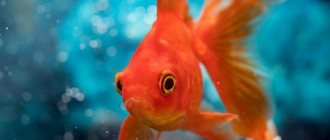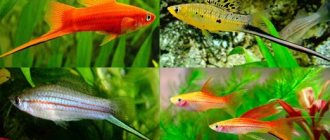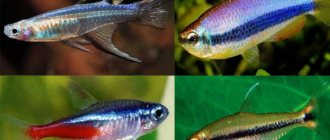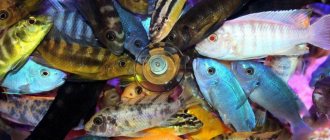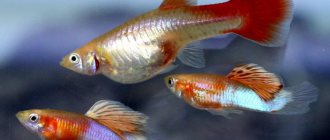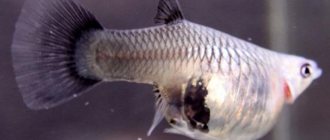Guppy (lat. Poecilia reticulata) is an aquarium fish that is known even to people who are very far from aquarium hobby, let alone amateurs. Perhaps every aquarist at least once in his life kept a couple of gupeshkas, and many started their journey with them, and even now keep luxurious, selected species. To answer all the questions about them, you probably need to write a book, but we will try to consider the most popular ones.
Habitat in nature
The guppy (Poecilia reticulata) is one of the most widely distributed tropical fish in the world and one of the most popular freshwater aquarium fish species. It is a member of the family Poeciliidae and, like almost all members of the family, is viviparous.
Guppies are native to Antigua and Barbuda, Barbados, Brazil, Guyana, Jamaica, Netherlands Antilles, Trinidad and Tobago, US Virgin Islands and Venezuela. They are very adaptable and thrive in many different environmental conditions.
As a rule, they live in clean, running water, but also like brackish coastal waters, but not salty sea waters.
They feed on worms, larvae, bloodworms and various small insects.
They have been introduced to many countries on every continent except Antarctica. Sometimes this happened by accident, but most often as a means of mosquito control. Guppies were supposed to eat mosquito larvae and help slow the spread of malaria, but in many cases these guppies have had a negative impact on local fish populations.
Research shows that guppies have colonized almost all freshwater bodies of water available to them in their natural ranges, especially in rivers located near the coastal margins of mainland South America. Although guppies are not usually found there, they also tolerate brackish water and have colonized some brackish habitats. They tend to be more numerous in small streams and pools than in large, deep or fast-flowing rivers.
Their name comes from Robert John Lechmere Guppy, who found them in Trinidad back in 1866 and brought them to the British Museum. Since then, the fish has undergone several name changes, including Lebistes reticulatus and is now known as Poecilia reticulata.
There are almost 300 varieties of guppies. They come in a wide variety of colors, sizes, and tail shapes. Males in nature are much brighter than females, but still their coloring is far from the aquarium breeding forms.
She must protect them from predators, since the fish is small and defenseless.
Two or three generations of guppies born in the same year are found in the wild. The fry are well developed and capable of independent existence without further parental care at the time of their birth. Females first produce offspring at 10-20 weeks of age and continue to reproduce until 20-34 months. The reproductive cycle is related to age. Older females produce offspring that are smaller in size and have longer intervals between births.
Males mature in 7 weeks or less. Male and female guppies from regions with high predation rates mature faster and begin reproducing earlier than males from regions with low predation rates. Females from regions with high levels of predation reproduce more frequently and produce more offspring per litter, and are more fertile than females with low levels of predation.
In addition to aging, food availability and density also play a role in regulating guppy populations. Guppies reduce their fertility in response to food scarcity. When there is plenty of food, they increase the size of the brood.
The overall lifespan of guppies in the wild varies greatly, but is usually around 2 years.
Homeland of the fish
The homeland of the guppy fish is the northern part of South America. But in order not to sound so abstract, they often say more specifically that their homeland is the islands of Barbados and Trinidad, which are located near the South American continent.
But the fish began to be bred en masse in areas where malarial mosquitoes were found (the fish eat their larvae), as a result of which the fish spread and the title of one of the most popular was assigned to them, so the guppy’s homeland is remembered only for history.
Description
As we already mentioned, guppies come in different colors and sizes, with different tail shapes. In the wild, females are usually gray, while males have colorful stripes, spots or splashes in a wide range of colors. There are many species of aquarium guppies due to the efforts of breeders to create new species with brighter colors and more patterns on their bodies and tails.
These fish are sexually dimorphic, meaning you can tell males from females just by looking at them. While females naturally have a gray body color, males have splashes, spots or stripes that can be any of a wide variety of colors.
As for appearance, it is almost impossible to describe. Guppies cross so often and so much that even dozens of selective forms can be counted, and even more common ones. Males and females of many species are typically larger in body size and much more ornate than their wild-type predecessors.
These fish come in almost every color imaginable, usually a paler color on the upper half of the body, and the back half usually a brighter color.
Some types can also have a metallic sheen. They have iridophores, which are cells that have no color and reflect light which creates a metallic effect.
A small fish, and males are smaller than females, and usually reach a length of about 5 cm. Males are usually 1.5-3.5 cm long, and females are 3-6 cm.
A guppy lives for 2-3 years, as its small size and warm water speed up metabolism and shorten its lifespan.
Where to buy and how much do they cost?
Buying these fish is not problematic; just visit a pet store or market, where there are enough private establishments. At this stage, it is very important to know that the ratio of females to males should be in the proportion of 2 to 1, that is, two females for one male.
Prices for aquarium fish Guppy depend on the breed group, age and size. Their cost ranges from 90 to 110 rubles per piece. It should be noted that even the rarest specimens are affordable for any aquarist.
Content complexity
A great fish for beginners and pros.
Small, active, beautiful, very easy to reproduce, undemanding in maintenance and feeding, it seems that the list can go on forever.
However, we would warn novice aquarists against purchasing bright, selective forms. How to understand that the form is selective? If all the fish in the aquarium are strictly the same color, and the males have long and uniform fins, then these are demanding species.
If the males are all different, like the females, the coloration is a riot of colors and colors, then these are the fish that the average aquarist needs.
The fact is that as a result of crossing, they become very beautiful, but also very capricious, losing their advantages.
Hybrid forms already have weak immunity and are very demanding in terms of maintenance. So if you just decide to try your hand at aquarium keeping, buy the simplest but colorful goops.
They will delight you no less than the selection forms, but they will live much longer and there will be fewer problems.
And for the pros there will be selection forms - they need to be carefully sorted, bred and cared for even more carefully.
Feeding
Wild guppies feed on algae debris, diatoms, invertebrates, plant fragments, mineral particles, aquatic insect larvae and other foods. Algal debris makes up the majority of wild guppies' diet in most cases, but diets vary depending on specific habitat conditions. For example, a study of wild Trinidadian guppies found that guppies primarily consumed invertebrates, while guppies from the lower region (lower Tacarigua River) consumed primarily diatoms and mineral particles.
Guppies are omnivores, which means they eat both plant and animal foods. They eat very different foods - artificial, frozen, live, even dry.
They eat flakes, granules and other artificial foods with pleasure, but it is better to choose well-known brands. Make sure you choose a product that is high in protein and not filled with fillers. To be sure, check the order of the ingredients (ingredients are listed by percentage). High quality foods will contain the proteins listed first (eg forage fish, shrimp and meat products). Avoid cereals that contain fillers such as wheat and soy listed as the first ingredients.
In addition to flakes, you can feed your fish either live or frozen foods. Among the living, the best food to eat are bloodworms, tubifex, brine shrimp, and coretra.
It is important to remember that guppies have a small mouth and stomach, the food should be small, and it is better to feed it two to three times a day, in portions that the fish will eat in 2-3 minutes.
Also, fish love food with a high content of plant substances, so that their gastrointestinal tract remains healthy and their immunity is high; in addition to regular flakes, buy food with herbal supplements and feed them twice a week.
You should feed your fish once or twice a day, and only feed as much food as they can eat within two minutes. You could feed them cereal in the morning and frozen food in the evening.
Don't feed your fish only one type of food because this will lead to nutritional deficiencies. You should alternate between flakes, live foods, frozen foods, and plant foods.
If you overfeed your fish, it can lead to health problems and affect the water quality in your aquarium. Following the above rule, there should be leftover food in the aquarium, but if there is, you can simply remove it so that it does not settle on the floor and begin to rot.
If you have fry in the aquarium, you also need to think about how to feed them.
They will need to be fed in smaller quantities, but more often. You can feed them either the same foods as adults, but crushed, or you can buy special food for fry. Feed them about four to five times a day.
Separately, I would like to say about dry food - this is not branded food, but dried daphnia, which is often sold at poultry markets. I strongly advise against feeding fish with this food, even guppies. It is poor in vitamins, nutrients and is essentially just a dried shell. It inflames the gastrointestinal tract of fish and they die.
Keeping in an aquarium
Their natural habitat is in the warm, fresh waters of South America, so it is important to replicate these conditions in your aquarium to provide them with as natural an environment as possible.
Guppies prefer water with a temperature of 25 to 27 °C and a salt level equivalent to one tablespoon per 20 liters. But you don't have to use salt at all (I never use it). Like all tropical fish, guppies love warm water (22-25 °C), but can live in a wider range of 19.0 - 29.0 °C.
You will need to use a heater to keep the water warm during the colder months. Always install a heater at one end of the tank and a thermometer at the other end to check that the water is heating evenly.
As for water parameters, for ordinary forms this practically does not matter. They adapt to local conditions so quickly that moving to a new aquarium is tolerated without any problems at all.
It would be ideal if the aquarium has: pH 7.0 - 8.5, and hardness 12.0 - 18.0, but the parameters can be completely different, which will not interfere with living and reproducing. While they can tolerate a wide range of water conditions and pH values from 5.5 to 8.5, their most ideal pH is between 7.0 and 7.2.
The aquarium can be small; 20 liters is enough for 5 fish. But, the larger the volume, the more fish you can contain and the more beautiful it will look.
It is best to have a lot of plants in the aquarium, as this will resemble the natural habitat and will significantly increase the survival rate of the fry in the general aquarium. Lighting can be anything from bright to dim.
As with most fish, you'll also need a filter - the type you choose will depend on the size of your tank and your personal preferences. An internal filter is perfect for most aquariums. If you keep your fish in a large tank (more than 100 liters), you may want to consider using an external filter. It’s just better to cover the holes in it with an additional fine mesh, since a powerful filter is not only capable of sucking in fry, but even adult fish.
Guppies cannot be called a schooling fish, but keeping them in pairs makes little sense. It is very small in size and in small quantities is almost invisible in the aquarium.
There is a simple rule for keeping them - the more of them in the aquarium, the more impressive and beautiful they look.
The type of substrate you choose is entirely a matter of personal preference. Guppies spend most of their time in the middle or upper part of the aquarium.
Regardless of the conditions, make sure you clean your tank weekly and perform partial water changes of about 25%.
Compatibility
A very peaceful fish that does not cause any trouble to its neighbors. But she can be offended, especially by large and predatory fish, which perceive the guppies only as food.
So you shouldn’t keep fish like swordmouth, giant gourami, pangasius or shark balu.
Also, you should not keep with fish that can tear off the fins of males - Sumatran barb, Denison barb, fire barb, some gourami, for example kissing, thorns.
They get along best with peaceful and small fish: - rasboras, cardinals, congos, neons, cherry barbs, speckled catfish, cockroaches.
Most people who keep this fish do so because they like the bright colors of the males. If you are keeping them just for their appearance, we recommend that you only keep males.
If you want to keep them with shrimp, the guppies themselves will not harm any type of shrimp, not even cherries. However, some large species of shrimp can prey on fish. Not to mention crayfish, for which guppies will simply be food.
Results
The aquarium fish guppy is bright, beautiful and looks especially good when it lives with its brothers. They are unpretentious, which makes them perfect for beginner aquarists, and everyone has at least once dreamed of owning this daredevil. If you want to find out who you can share with her, then read our article on the compatibility of guppies with other fish.
Previous
Fish How many aquarium fish are compatible with the betta fish?
Next
Fish Sturisoma Panama - a picky catfish for beginners
Guppy diseases
Guppies are very hardy fish, but their long tails can make them prone to fungal infections.
Semolina is common among these fish. This is a condition where small white dots grow on the fish's skin and you will notice them rubbing their body against objects. The whole body of the fish seems to be sprinkled with semolina.
To get rid of semolina, you can use medications available at your local pet store. There is no specific recipe, because semolina strains are varied and are treated differently.
They are also prone to fin rot; the tail will look like it is torn. Again, this can be treated with medication and prevented by choosing suitable tank mates that will not nibble their tails.
To reduce the chance of disease entering your aquarium:
- Maintain optimal temperature conditions.
- Change the water and maintain the filter regularly.
- Always rinse or quarantine everything before adding to your tank.
- Keep your fish's stress levels low.
- Feed them a variety of foods.
- Don't overfeed them.
Kinds
Thanks to their easy maintenance and care, guppies have earned the recognition and love of fans of the underwater world, which forced breeders to work hard on breeding different forms and species. Fish are divided into breeds and varieties based on the type of tail and fins:
- Flagtails
- Veiled tails
- Speartails
- Fantails
- Acute-angled
- Double sword, etc.
Popular breeds include the following:
- German yellow - representatives are painted in rich sunny tones with various shades. The scales have a beautiful iridescence, the head is light in color.
- Moscow blue is a fish with a rich blue color. Body color can vary from blue-black to bluish, silver and cream.
- Moscow blue-green - representatives are painted in blue-green tones with bluish, light, dark and golden splashes. The head of the fish is light silver in color.
- Venezuelan Japanese are miniature fish with dark, scarlet, gold, blue and green stripes and spots.
- Black Prince - The breed has a black tail, light silver or gold head, and blue, violet or silver fins. There are also pure black representatives.
- Red dragon is a bright scarlet fish with eyes of the same shade. Some representatives have inclusions of other colors.
- Tiger - representatives of the breed sport a striking color in orange and yellow tones, which gives the fish a resemblance to a tiger.
- Neon guppies have a pale blue tail and a light or golden belly. There may be inclusions of white, dark and greenish tones on the body of the fish.
- Sunset mikarif are miniature individuals with a silver tint and yellowish fins. The tail of the fish is edged with a scarlet border.
Sex differences
Guppies exhibit pronounced sexual dimorphism. It is very, very easy to distinguish a female from a male. Males are smaller, slimmer, they have a large caudal fin, and the anal fin has turned into a gonopodium (roughly speaking, this is a tube with the help of which male viviparous fish fertilize the female).
Females are larger, have a large and noticeable belly and are usually quite pale in color.
Even juveniles can be distinguished quite early; as a rule, those of the fry that first began to color will be males.
Reproduction
Guppies have a mating system called polyandry, where females mate with multiple males. Repeated mating is beneficial for males because males' reproductive success is directly related to how many times they mate.
Guppies are very fertile living creatures. The female's gestation period is usually 21-30 days, varying significantly depending on housing conditions. Male guppies, like other members of the family Poeciliidae, possess a modified tubular anal fin called a gonopodium located just behind the ventral fin. The gonopodium has a channel-like structure through which bundles of sperm are transmitted to the females.
Once fertilized, female guppies can store sperm in their ovaries, which can continue to fertilize eggs for up to eight months. Due to their sperm storage mechanism, males are capable of postmortem reproduction, meaning a female can give birth to a male's offspring long after he has died, making a significant contribution to the reproductive dynamics of wild guppie populations.
One of the easiest fish to breed is ordinary guppies; they breed very easily in home aquariums.
The fact is that they are viviparous, that is, the female carries the eggs in her stomach, and a fully formed fry is born.
For the first hours he will lie down and hide, but very soon he will begin to swim and feed.
To breed these fish you need... a male and a female. Not even that, one young and active male is enough to court 3-5 females tirelessly.
That is, for successful breeding it is quite possible to keep one male for 3-5 females. More males are possible, since males do not fight with each other, but only compete. You will see how the male tirelessly pursues the female, but this is normal and you do not need to do anything about it.
The fact is that during such pursuits he impregnates the female and soon you will have fry.
What does it take for a couple to reproduce? Fresh and clean water, good and plentiful feeding and a couple of fish of different sexes.
As a rule, guppies reproduce quite successfully in a community aquarium without any participation from the owner. But they also eat their fry, and neighbors will help if they are there. This means that it is better to place pregnant females in a separate aquarium.
How can you tell if you have a pregnant female? In a pregnant female, the spot near the anus begins to darken, this can already be seen by the eyes of the growing fry, and the darker it is, the sooner she will give birth.
Place the mother in a separate aquarium, with the same water and thickets of plants, where the fry can hide from her (yes, she can eat her children). When the due date comes (maybe up to a month, if you were in a hurry to put her away), she will give birth without any problems.
Immediately after giving birth, the female needs to be bred. Taking care of the fry is quite simple, just like taking care of the parents.
What to feed the fry? You can feed them finely ground branded flakes (which you feed the parents), but it is better to feed them dry egg or branded food for fry. Note that there is such a relic of the past as dry food.
This is dried daphnia and cyclops and can still be found commercially. So, it is strictly not recommended to feed fry this rubbish. The nutritional value there is slightly higher than zero; in fact, it is an analogue of battering ram. Will you grow a lot if you eat one ram? The same can be said for adult fish.
They need to be cleaned regularly so that any leftover food does not spoil the water. You can also introduce snails into this aquarium, such as an ampoule or a coil. They do not touch the fry, but will eat the leftover food.
How a fry is born:
It is important that the water is clean, but it is impossible to change a lot at once, since the fry are still weak and a large water change is dangerous for them. The easiest way is to change about 10% of the water every one or two days, or 25% once a week.
The water temperature for fry is very important, and you need to keep it at 24-26.5 C.
With proper care and feeding, the fry grow quickly and within a month or a month and a half begin to color.
Frequently asked questions about guppies
What fish can you keep with them?
Some species have already been listed above, but you can also look at the article - the 10 best fish for beginners; everything on this list is good for keeping.
How do you know if a guppy is pregnant or about to give birth?
Typically, the female gives birth to fry once a month, but the timing may vary depending on the water temperature and conditions of detention. Note the time since the last time she gave birth and observe. In a female ready for another birth, the spot becomes darker; the eyes of the fry are visible.
How does a guppy breathe?
Like all fish - dissolved oxygen in the water, do not forget to include aeration and filtration.
How long do guppies live?
About two years, but it all depends on conditions and temperature. The higher the water temperature, the shorter their life. Some fish live up to 5 years.
How often should you feed your guppies?
Every day, and in small portions two to three times a day. For example, morning and evening.
Once a week you can have a fasting day, but keep in mind that the fish will actively look for food and the first victims will be their own fry.
Why do guppies' tails break?
There could be many reasons, but the most common is old water that is rarely changed. Ammonia and nitrates accumulate in it, and they poison fish and destroy fins. Replace the water regularly with fresh water.
There may also be a sudden water change, injury or poor feeding when there are few vitamins.
If the fish's tail is missing, then this is an alarming sign - either someone is cutting it off, and you need to carefully examine the fish with which it is kept, or it has contracted an infectious disease, and you need to take an even closer look at the other fish.
Why does a guppy's tail stick together?
Again - either old and dirty water, or an infection, or poor feeding. Try changing 20% of the water once a week and monitor the condition of other fish.
Why does a guppy have a crooked spine?
Such fish are found in almost any species; as a rule, this is a defect from birth. If this happens in an adult fish, it may be due to the fact that it is kept in too small an aquarium, with a large number of fish.
Most often, the spine also curves due to old age, and this is normal, but the most common cause is fish tuberculosis or mycobacteriosis.
The disease is complex, and its treatment is not easy and does not always bring results. To avoid the spread of infection, it is better to isolate such fish.
Why do guppies only give birth to females?
An exact answer to this question has not been found. Apparently, when there is an excess of males, the laws of nature come into play and the population compensates for the females in order to preserve itself.
Is it possible to keep only one guppy in an aquarium?
It’s possible, although it looks a little sad...
Still, this is a cheerful and lively fish that loves company. If you are looking for a fish that would be beautiful, unpretentious and would live wonderfully on its own, then look towards the betta.
Do guppies need oxygen and a filter?
Not required, but recommended. You can buy an inexpensive internal filter with a sponge. It will perform its functions quite well and will not suck in fish.
Please note that if you bought a filter and it is placed higher (so that the surface of the water in the aquarium is in motion), then you have absolutely no need to buy additional aeration or, more simply, oxygen.
Does a guppy need soil and plants?
It's your choice. An empty aquarium is easier to clean, but it looks worse, the fry can’t survive in it, and the frogs themselves like to frolic among the plants. I am for an aquarium with soil and plants.
Does a guppy need light?
No, fish do not need light at all, other than what falls on the aquarium during the day. Plants need light to grow.
Do guppies spawn?
No, they are viviparous. That is, the fry is born completely ready for life and can immediately swim.
Sometimes he falls out in the egg, but it breaks and he swims. Sometimes it has a yolk sac, which it quickly digests.
Do guppies sleep?
Yes, but not like people. This is more of an active holiday, when at night the fish reduce their activity, but still swim.
And it’s better to turn off the lights at night, although some people don’t do this, but isn’t it dark in nature at night?
How many fry does a guppy give birth to?
Depends on the female, her age and size. Usually there are about 30-50 pieces, but sometimes there are 100.
How long does a baby guppy grow?
Very fast in good conditions. Males become sexually mature at two months, and females at three.
Can guppies be kept in sea water?
No, they tolerate lightly salted water well, but they die in sea water; these are freshwater fish.
Why do guppies swim on the surface?
They breathe oxygen dissolved in the water, and your aquarium does not have enough of it. Because of which? Perhaps it’s too hot, perhaps you haven’t cleaned the aquarium or changed the water for a long time, perhaps it’s too crowded.
Be sure to turn on aeration or filtration (place the filter closer to the surface of the water to enhance gas exchange) and replace some of the water with fresh water.
Why do guppies jump out of the aquarium?
They can do this either accidentally or because of bad water - for example, if it has not been changed for a long time and the soil in the aquarium has not been siphoned off.
The reason may also be a low amount of oxygen in the water, read about this above.
Why does a guppy's tail stick together or stick together?
Unfortunately, it is impossible to pinpoint the exact reason, even if the aquarium is near you. This may be improper feeding (monotoneous, only dry food or plenty of it), the water parameters may be unsuitable (too much ammonia), or it may be illness.
The minimum that needs to be done is to change some of the water, siphon the soil and change the type of food.
What kind of catfish can you keep with guppies?
Any small ones. More or less large catfish, almost all predators. The only exception is the cockroach; it can be kept with small fish.
Well, any corydoras, for example the speckled one, will get along well with viviparous animals and will be very useful, eating up the remaining food from the bottom.
How to care for baby guppies?
The most unpretentious of the fry, they survive in the wild. But, if you regularly change the water, give enough food for them to eat in a couple of minutes and feed the fry two or three times a day, then they will grow quickly, color and delight you.
Tail problems
Owners often encounter the phenomenon of torn tails on these fish. The reasons for such a violation may be the following:
- Keeping guppies in old, muddy water, without changing . In this case, harmful substances - ammonia, nitrates - begin to accumulate in the aquatic environment. They cause intoxication in fish, as well as destruction of fin tissue. It is recommended to change the water regularly.
- Abrupt water change . Even such tenacious and hardy fish as guppies can get sick and die when water parameters completely change.
- Vitamin deficiency . With a lack of vitamins, the appearance of the fish can change noticeably. Males become duller, their fins become fragile and can break even for no apparent reason.
- Injury . Although guppies are not pugnacious fish, their more active neighbors may well bully them. In addition, fish can get caught on sharp objects, damaging their fins, including the tail. This is especially true for individuals with luxurious characteristics - ribbon, veil-tailed, and plume-tailed.
The fish’s tail may also completely disappear, and aquarium owners should be wary of this situation. This may be due to aggressive, predatory neighbors who “offend” the small inhabitants. Or the fish has contracted an infectious disease and more attention needs to be paid to the condition of the rest of the charges.
Tail matting is another change that can result from infection, living in a dirty tank, or poor nutrition. You should replace 20-25% of the water weekly and watch the rest of the fish more closely.


